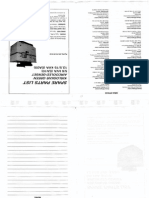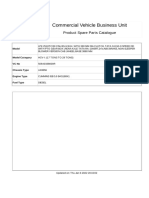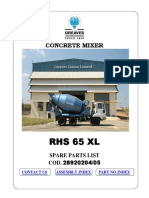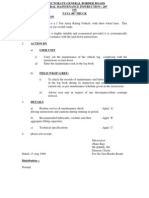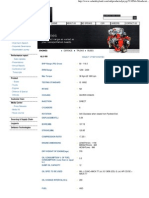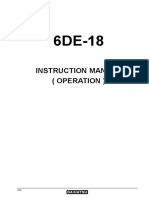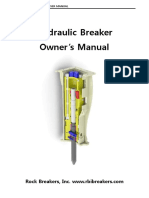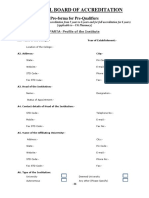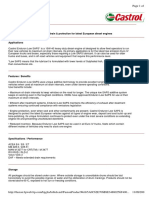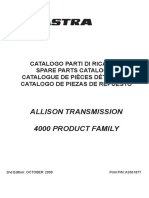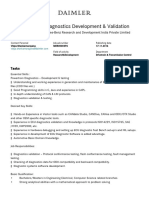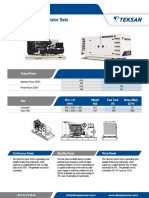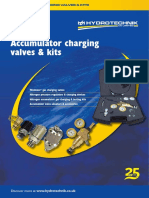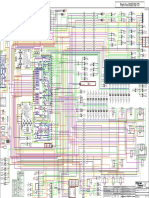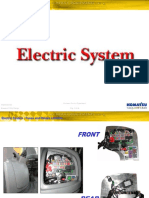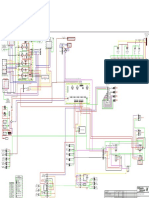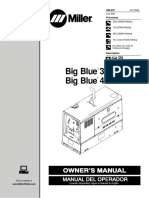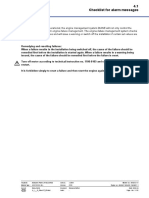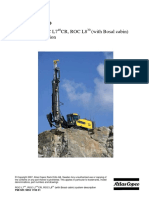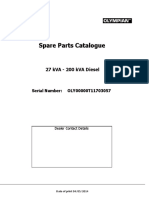Ee 483 TC
Ee 483 TC
Uploaded by
mnvijaybabuCopyright:
Available Formats
Ee 483 TC
Ee 483 TC
Uploaded by
mnvijaybabuOriginal Description:
Original Title
Copyright
Available Formats
Share this document
Did you find this document useful?
Is this content inappropriate?
Copyright:
Available Formats
Ee 483 TC
Ee 483 TC
Uploaded by
mnvijaybabuCopyright:
Available Formats
OPERATION AND MAINTENANCE MANUAL
EE483TC & EE483TCI Power Generation Engine
Pub. No : M190456 : 01 Nov 2012
Downloaded from www.Manualslib.com manuals search engine
CONTENTS
Section Details Page No
Introduction-Operation & Maintenance
Part I 2
Manual
Part II Eicher Engine - General Information 3
Engine Familiarization
3 General Information 4
3.1- Engine Identification 4
3.2- Engine Nomenclature 5
3.3- Engine orientation and Parts
6 to 8
Illustration
Part III 3.4- Technical Specification- Engine 9 to 10
3.5- Engine Systems and Function 11
3.5.1- Air Intake and Exhaust System 11 to 13
3.5.2- Lubrication System 14 to 17
3.5.3- Fuel System 17 to 19
3.5.4- Cooling System 20 to 21
Part IV Engine Electrical System 22 to 23
Part V Safety Guidelines 24 to 25
Part VI Recommended Routine Checks By user 26 to 28
Part VII Engine Inspection and Maintenance 29 to 38
Part VIII Trouble Shooting Guidelines 39 to 47
Downloaded from www.Manualslib.com manuals search engine
PART I-INTRODUCTION - OPERATION & MAINTENANCE MANUAL
We are glad to introduce us as VE Commercial Vehicles Ltd (VECV), manufactures of EICHER EE483TC and
EE483TCI Power Generation Engine owned by you. VECV is committed to being the leader in customer
satisfaction in India and emerging markets. We put our best efforts to maintain global quality levels by
understanding and fulfilling customer needs.
This manual presented to you gives a comprehensive understanding on Construction, operation and
Maintenance aspects of Engine for the intended application.
These Engines meets current prevailing emission norms.
Due care has been taken in preparing this manual. However due to Continuous improvements product
specifications and illustrations are likely to undergo change without any prior notice.
For any further information, please write to:
PRODUCT SUPPORT
NON AUTOMOTIVE ENGINES
VE Commercial Vehicles Limited
(A Volvo Group and Eicher Motors Joint Venture)
102, Industrial Area No. 1 Pithampur 454775 Dist. Dhar (M.P.) India
Phone: (07292) 402633
Fax: (07292) 402611
PUBLICATION NO: M190456:00 REVISION NO: 01
PUBLICATION MONTH: NOVEMBER’2012 REVISION DATE: 01/11/2012
Downloaded from www.Manualslib.com manuals search engine
PART II: EICHER ENGINE GENERAL INFORMATION:
Eicher EE483TC Engines manufactured by VE Commercial Vehicles Ltd (VECV) are direct injection, four
Strokes, Water cooled, and Turbo charged Diesel Engines designed to suit Power Generation application.
Eicher EE483TCI Engines manufactured by VE Commercial Vehicles Ltd (VECV) are direct injection, four
Strokes, Water cooled, Turbo charged, Intercooled Diesel Engines designed to suit Power Generation
application.
The engines are eco-friendly, reliable and fuel efficient meets prevailing statutory emission standards.
While we, at manufacturing and testing have taken due care to ensure trouble free performance, as an
engine owner and user, proper up keep of engine, use of genuine parts, use of Genuine oil and Lubricants,
use of Genuine Coolant and adherence to scheduled and preventive maintenance shall derive the best out of
your engine resulting in Value for investment.
Downloaded from www.Manualslib.com manuals search engine
PART III: ENGINE FAMILIARIZATION
3. GENERAL
This part provides details about engine identification, engine Sl No nomenclature, Orientation, technical
specifications and various Systems of engine.
3.1 ENGINE IDENTIFICATION.
Engine is identified with the engine nameplate fitted on flywheel housing on left hand side of the engine
when viewed from front. Engine name plate contains the information as shown in the figure 1, 2 and 3.
Engine Sl No is also punched on the Cylinder block as shown in the figure 4.
Fig- Fig 2 – EE483TC-48 Kw
1- EE483TC-38 Kw
Engine Sl No Punched on Cylinder Block
Fig-4
Fig-3-EE483TCI-59 Kw
Downloaded from www.Manualslib.com manuals search engine
3.2 ENGINE NOMENCLATURE:
G- Identification for Power
EE 4 83 C D B A 100000 G Generation Engine
Running Serial number
Month of production (A to M), A= Jan
& M = Dec.
Note: “I” is omitted
Year of production (A to W), A= 2010
W=2028.
Note: “I” is omitted
Type of fuel used
(D=Diesel)
Version: N=NA (Naturally aspirated)
C= TCI (Turbo Charged intercooled)
T=TC (Turbo Charged)
Swept Volume per cylinder
83=0.83 Litres
No. of Cylinders (4 or 6)
EICHER
Downloaded from www.Manualslib.com manuals search engine
3.3 ENGINE ORIENTATION AND PARTS ILLUSTRATION (EE483TC -TURBO CHARGED ENGINE):
1 2 3 4 5 6 7 8 9 10 11 12 13
14 15 16 17 18 19 20 21 22 23 24 25 26
1 Radiator 14 Strip-Support radiator
2 Radiator Cap 15 Shroud Radiator
3 Hose- Radiator In 16 Guard Fan Radiator
4 Tank Condenser 17 Fan Cooling Radiator
5 Bracket – Radiator Support 18 Pipe- Fuel filter to Fuel injection pump
6 Cushion-Radiator Support Bracket 19 Stop Solenoid
7 Cap Oil Filler 20 Feed pump
8 Pipe- Turbo to Intake Manifold 21 Pipe fuel- Feed Pump to fuel filter
9 High Pressure Pipe 22 Fuel injection Pump
10 Rocker Cover 23 Oil Sump
11 Hose- Turbo out 24 Starter Motor
12 Hose Breather 25 Dip Stick
13 Air cleaner Assembly 26 Flywheel
Downloaded from www.Manualslib.com manuals search engine
ENGINE ORIENTATION AND PARTS ILLUSTRATION (EE483TC -TURBO CHARGED ENGINE) CONTD:
27 28 29 30 31 32 33
34 35 36 37 38 39 40 41 42 43 44 45 46
27 Hose – Air cleaner 37 Pedestal- Rear for Transportation
28 Switch-Choke Air Cleaner 38 Hose- turbo charger in
29 Pipe- Lubrication Turbocharger 39 Turbo charger
30 Manifold- Exhaust 40 Filter Oil – Main
31 Cooler- Oil 41 Bend Exhaust
32 Manifold- Intake 42 Filter- By Pass
33 Switch Cum Sensor- Water Temperature 43 Pedestal – Front
34 Pipe- Air Cleaner to Turbo 44 Sensor-oil Pressure
35 Housing flywheel 45 Alternator- Battery charging
36 Engine Identification plate 46 V Belt- Engine/Alternator/Water pump
Downloaded from www.Manualslib.com manuals search engine
ENGINE ORIENTATION AND PARTS ILLUSTRATION (EE483TCI -TURBO CHARGED INTERCOOLED ENGINE):
1 2 3 4 5 6 7 8
1 Hose-Air Filter to Pipe TC in B 5 Intercooler Assy
2 Pipe TC in B 6 Hose – Thermostat to Radiator
3 Hose- Intercooler Outlet 7 Pipe-Turbo Charger to Intercooler inlet
4 Pipe TC in A 8 Hose-Pipe Intercooler inlet to Intercooler in
Downloaded from www.Manualslib.com manuals search engine
3.4 ENGINE TECHNICAL SPECIFICATIONS:
Details
Parameters Unit
40 Kva 50 Kva 62.5 Kva
Engine Manufacturer Name VE Commercial Vehicles Ltd
Engine Make Make EICHER
Engine Model Model EE483TC EE483TC EE483TCI
Emission Compliance Standard CPCB1 – As Per GSR 448 (E) 12.07.2004
No of Cylinders Nos. 4
Engine Configuration Configuration Inline / 4 Stroke
Turbo Charged
Engine Aspiration Type Turbo Charged
Inter cooled
Engine Fuel Type High Speed Diesel
Combustion Chamber Type Type Direct injection
Cylinder Bore X Stroke Mm 100 X 105
Engine Displacement Litres 3.3
Compression ratio Ratio 17:1 ± 0.5 mm
38 (52) @ 48 (65) @
Engine Rated Output Kw ( HP) @ RPM 59 (80) @ 1500
1500 1500 RPM
Ambient /
Standard Operating 25°C / 40 % / 1000 mbar
Relative Humidity
Conditions
/ Altitude
Engine Deration Applicability Above 4000 feet
Rating Standard Standard IS10000
10 % over load Permissible for 1 Hour in Every
Overload Permissibility
12 Hours of Operation
Governing Standard Standard BS5514 / IS 10000
Governing Class Class A1
Engine Low Idling Speed RPM 700 ± 50
Engine Fly Up Speed RPM 1560 ± 10
Engine Firing order Sequence 1-3-4-2
Direction of Rotation Direction Anti Clock wise when viewed from Flywheel End
Flywheel Standard SAE J 620 SAE 10 SAE 11.5
Flywheel Housing Standard SAE J 620 SAE 3 SAE 2
Lubrication Method Method Oil Pump Forced feed system
Oil Pump Type Gear Type
Oil Filter-Main Type / Nos. Paper Type / Single
Oil Filter-By Pass Type Spin on Type Paper
Oil Cooler Type Shell Type
API CH4-SAE 15W40 / EICHER Premium Diesel
Specification / Engine Oil
Engine Lubricating Oil Grade /
Recommendation
Downloaded from www.Manualslib.com manuals search engine
Details
Parameters Unit
40 Kva 50 Kva 62.5 Kva
% of Fuel < 0.15 %
Lubricating Oil Consumption
Consumption
Minimum Lubricating Oil
Bar 1.5
Pressure @ Low Idle
Max Lubricating Oil Pressure
Bar 5.5
@ Fly up Speed
Fuel Injection Pump Make/Type Bosch / Inline
Fuel Filter Type / Nos. Cartridge type / 2 Nos.
Cooling Method Method Liquid Cooling / Forced Circulation
Centrifugal
Water Pump Type
Specification / JIS-K-2234-94 / EICHER GENUINE RADIATOR
Coolant
Recommendation COOLANT
Engine Cooling Fan Type Pusher
Electrical System V 12
Starter Motor Make / V / Kw Bosch / 12 / 1.9 Kw Bosch / 12 / 3.2
Battery Charging Alternator Make / V / Amps Bosch / 14 / 49
Shut off Solenoid Type Energise to Stop
Switch – Low Oil Pressure Applicability Yes
Switch – High Coolant
Applicability Yes
Temperature
Switch- Air Cleaner Choke Applicability Yes
Sensor-Water temperature Applicability Yes (Integral Design with Switch)
Sensor-Lubricating Oil
Applicability Yes
Pressure
10
Downloaded from www.Manualslib.com manuals search engine
3.5 ENGINE SYSTEMS AND ITS FUNCTION:
As we all know, Diesel engine is a prime mover developing useful power. Air and fuel is required to produce
power. Lubrication is necessary for the moving parts of the engine. Continuous cooling is required to
dissipate heat generated during combustion. Electrical system is required for engine starting, battery
charging and sensing of critical engine operating parameters.
The construction of Eicher diesel engine is divided in to five parts as below.
1 Air intake and Exhaust System
2 Lubrication System
3 Fuel System
4 Cooling System
5 Electrical System
The below section provides details of function, key components and working principle of respective system
to understand better about Engine aspects.
3.5.1 AIR INTAKE AND EXHAUST SYSTEM
TURBO CHARGED INTERCOOLED ENGINES:
The function of air system is to supply clean, cool and sufficient quantity air required for proper combustion
of the fuel which results in designed power output of the engine and maintains emissions as per statutory
norms.
Air intake system facilitates cleaning of air, induction of air, compression of air through turbocharger and
cooling by intercooler.
Air is sucked from atmosphere and passed through the Air filter to restrict dust and other foreign particles
from entering into air intake system. Clean air is then induced and compressed by the turbocharger
compressor wheel. Turbocharger increases the temperature of the air. This high temperature air is then
passed through an intercooler which decreases its temperature. As air inducted cools down its density is
11
Downloaded from www.Manualslib.com manuals search engine
further increased. Due to more air with desired density of air inducted into the engine there will be complete
combustion resulting in:
• Increase in power and torque without increasing the size of the engine.
• Improves fuel economy.
• Reduce engine noise.
• More complete combustion resulting in cleaner emission
TURBO CHARGED ENGINES:
In turbo charged engines, intercooler will not be present. The Compressed air from turbo charger will be
directly inducted into the combustion chamber. The combustion parameters will be designed to suit the air
temperature inducted in to the combustion chamber and accordingly desired quantity of fuel will be
supplied to ensure better fuel economy and complete combustion to achieve emission characteristics.
AIR FILTER:
Air filter is fitted on the Suction Side. It is paper cartridge dry type air filter comprising of inner and outer
element. Air filter prevents dust and other foreign particles entering into the air inlet system. The restriction
Indicator fitted on the filter gives indication when air filter gets clogged.
Do not run the engine with clogged air filter. Clogged air filter reduces
power output, fuel efficiency; higher exhaust emissions and affects
engine performance.
Air filter outer element shall be cleaned whenever the restriction
indicator gives indication. There are limitations for cleaning as
frequent cleaning affects air filter filtration efficiency. Follow the
recommendation for cleaning procedures and permissible number of
cleaning.
The inner element should not be cleaned and it should be replaced.
Never run the engine without air filter. Running without air filter will cause foreign object entering into air
system and results in turbocharger and engine failures.
TURBO CHARGER:
The exhaust gases discharged from the combustion chamber are driven out through the exhaust manifold
into the turbo charger and accelerated in the turbine housing to turn the turbine wheel driving away the
Exhaust gases through the muffler to the atmosphere.
Simultaneously, the compressor wheel mounted on the same shaft spins at the designed speeds. The
centrifugal action draws air from air cleaner and builds up the boost pressure in the intake system.
12
Downloaded from www.Manualslib.com manuals search engine
SILENCER:
Silencer is used to reduce the noise of exhaust gas /
Smoke.
The exhaust gas is sent through a number of small holes
provided inside the silencer which results in sudden
expansion of exhaust gases.
This results in reduction in exhaust noise.
For specific applications like Power Generation residential
mufflers are used to achieve reduction in noise levels.
INTER COOLER (APPLICABLE FOR TURBO CHARGED INTERCOOLED ENGINES):
Compressed hot air from turbocharger flows through the
tubes of intercooler.
Pusher type radiator cooling fan charges Cold air through the
intercooler fins carries away the heat from compressed hot air
flowing through the intercooler tubes thereby reducing the
temperature of air to the designed temperature levels. This
compressed cold air rushes in to the combustion chamber.
13
Downloaded from www.Manualslib.com manuals search engine
3.5.2 LUBRICATION SYSTEM:
The engine has a forced lubrication system. The main functions of the Lubrication systems are as follows:
• Lubricates moving engine parts by forming a thin film of oil between components and prevents
metal to metal contact
• This oil film is capable of absorbing shocks in Con-rod Bearings and Gear train
• Flowing oil absorbs heat and cools engine parts
• Oil also collects carbon & metal particles formed during engine operation and flows it to the oil pan
• Oil neutralizes the acids and alkali produced during engine operation & prevents corrosion
• Seals compression by forming a thin oil film on cylinder liner walls
ENGINE OIL FLOW PATH:
14
Downloaded from www.Manualslib.com manuals search engine
SCHEMATIC DIAGRAM OF LUBE OIL FLOW:
22
1. Oil Strainer 4B. Bypass valve 8C. Timing gear 15. Auxiliary gallery
2. Oil Pump 5. Main oil gallery 9. Connecting rod bearing 16. Oil jet for piston cooling
2A. Relief valve 6. Engine oil pressure switch 10. Camshaft bushing 17 Piston
3. Oil cooler 7. Bypass filter 10A. Camshaft bushing no.1 18 Con rod bushing
3A. Bypass valve 7A. Restriction orifice 11. Rocker bushing 19. vacuum pump
3B. Regulator valve 8. Crankshaft main bearing 12. Push rod 20. Turbocharger
4. Filter element 8A. Crankshaft main bearing no. 1 13. Tappet 21. Oil sump
4A. Oil bypass alarm 8B. Idler bushing 14. Pressure control valve 22.Fuel Pump
The oil required for lubricating the engine parts is sucked by the oil pump from the sump through the
strainer.
The pressurised engine oil is then sent to oil cooler, where the oil is cooled and then it is sent to the oil filter
for filtration.
The filtered oil is then sent to all engine parts through main oil gallery. By pass oil filter is provided for fine
filtration.
LUBE OIL PUMP:
The oil pump is of gear type and is driven by the skew gear
mounted on the camshaft.
The oil pump cover also serves as the oil filter head, requiring no
oil pipe.
Engine oil is pressurised to the required pressure by the oil pump
and sent to various parts for lubrication and cooling.
15
Downloaded from www.Manualslib.com manuals search engine
OIL COOLER:
Shell type oil cooler facilitates heat dissipation from engine
lubricating oil and maintains engine lubricating oil temperature and
viscosity to the desired levels.
The Pressurised oil from oil pump is sent into the oil cooler for
cooling the hot engine oil. The coolant from the cylinder block is
passed through oil cooler element, which takes away the heat from
the engine oil.
LUBE OIL FILTER:
The full flow barrel type paper filter removes carbon and fine metal
particles formed during normal operation of engine. The filtered oil
is sent to Main oil gallery.
BY PASS FILTER:
The Spin on type by pass filter mounted on engine block through
adopter which has a small orifice is used for fine filtration of
lubricating oil.
The bypass filter allows a portion of main gallery oil to flow
through it & back to the oil pan through an adopter having a small
orifice.
During replacement the whole filter to be replaced
TURBO CHRAGER LUBRICATION:
Oil from oil main gallery flows through the oil tube to bearing housing
of turbocharger to lubricate bearing and is returned through the
outlet tube at the bottom of the bearing housing through the crank
case and to the oil pan.
16
Downloaded from www.Manualslib.com manuals search engine
FUEL INJECTION PUMP LUBRICATION:
Oil from oil gallery flows through benzo tube to FIP & lubricates
camshaft and governor mechanism and then drained to the oil
sump from the FIP gear side of FIP housing.
Pipe Lubrication - FIP
3.5.3 FUEL SYSTEM:
The function of fuel system is to feed the engine with clean and sufficient quantity of fuel as per designed
requirements.
Fuel Tank Feed pump Fuel Filter Fuel Injection Pump Injection
Nozzle Return line Diesel tank
The fuel system consists of the injection pump, fuel filter, injection nozzle, injection pipe and other parts. Fuel
is fed from the fuel tank through suction pipe to the feed pump of the fuel injection pump assembly and then to
the fuel filter, injection pump and injection nozzle.
The excess fuel is returned from the Nozzle to injection pump and to the fuel tank.
17
Downloaded from www.Manualslib.com manuals search engine
WATER SEPARATION FROM FUEL:
The air moisture trapped inside the fuel tank gets condensed during night time, becomes water and mixes
with diesel. If this water is allowed to flow through the fuel system it can damage the FIP and nozzle.
Since the engines are used for power generation application which is operated under stationery condition,
the fuel tank acts as water separator. The foreign particles in fuel are collected as sediments in fuel tank
bottom and water in fuel are collected at the bottom of the fuel tank. Ensure periodical draining of water
from fuel tank through the drain plug provided in the fuel tank.
Ensure periodical cleaning of Fuel tank to make it free from Sediments.
Do not top up fuel in fuel tank when the engine is under operation as the process will allow sediments and
water to float and gets carried away along with fuel. Always top up fuel in fuel tank when the engine is not in
operation. Wait for few minutes and allow sometime for sediments and water to settle at the bottom of the
fuel tank before starting the engine.
FEED PUMP:
The feed pump is driven by the Fuel injection pump
camshaft.
The priming pump allows manual lift of fuel when the
injection pump is stationary. It may be used when bleeding
the system.
The gauze filter removes large particles of dust from the fuel
lifted from the fuel tank, preventing the feed pump from
getting clogged. The filter must be washed in clean diesel
periodically.
FUEL FILTER:
The fuel from the feed pump is supplied to fuel filter for filtration. The dual filter is of element type and
replaceable individually.
18
Downloaded from www.Manualslib.com manuals search engine
Fuel from feed pump flows into the outer side of the filter housing and filtered by the element and supplied
to the fuel injection pump. The above diagram shows the flow path of fuel in fuel filter.
FUEL INJECTION PUMP:
The Bosch in line type fuel injection pump is used. The injection
pump, that forces fuel into the injection nozzle under pressure is
provided with a mechanism to increase or decrease the amount of
fuel. It has one plunger and delivery valve for each cylinder.
The plunger pushed up by the camshaft and pushed back by the
plunger spring, moves up and down in the plunger barrel on a
predetermined stroke to feed fuel under pressure. In doing so it
opens and closes the suction and discharge ports to adjust the fuel
injection rate.
The Constant speed governor of the fuel injection pump is capable of holding rated speed steadily
irrespective of variation in loads.
INJECTION NOZZLE:
The injection nozzles are of the hole type. The fuel delivered from
the injection pump enters the nozzle holder. When it reaches the
specified pressure value, the fuel overcomes the spring force to push
up the needle valve of the nozzle tip, spraying from the injection
orifice at the end of nozzle into the cylinder.
The injection pressure can be adjusted by increasing or
decreasing the number of washers in the spring.
19
Downloaded from www.Manualslib.com manuals search engine
3.5.4 COOLING SYSTEM:
The function of the cooling system is to absorb and dissipate heat generated during combustion thereby
maintaining engine coolant temperature as per designed parameters. To ensure the same the engine is
cooled by forced circulation of coolant by the water pump. Radiator cooling fan driven by the V Belt from the
water pump pulley charges cold air through the radiator fins which carries away the heat from the coolant.
This continuous process of circulation and heat dissipation ensures the operating temperature of the engine
is maintained.
The coolant temperature around the combustion chamber should be maintained at optimum levels for
satisfactory performance of the engine. It takes more time to achieve the desired operating temperatures at
low ambient temperatures, engine warm up periods and light loading conditions. Hence a thermostat is
installed in the cooling system which controls the coolant temperature around the combustion chamber to
the desired level all times during engine operation.
WATER PUMP:
The water pump is of centrifugal type and it is
driven by the V-belt from the crankshaft
pulley. A unit seal is installed between the
impeller and Water pump to prevent leakage
of coolant. There is drain hole provided at the
bottom of the water pump case which
ensures that coolant, should it leak from the
unit seal, does not enter the bearings. The
water pump is mounted on the timing gear
case provided with a suction pipe and swirl
chamber. Pressed into one end of the water
pump shaft is the impeller with backward
blades which feeds coolant under pressure
into the engine.
20
Downloaded from www.Manualslib.com manuals search engine
THERMOSTAT:
The thermostat is of a bottom bypass configuration, has a
valve controlled by a special wax enclosed in a pellet. The
wax changes from solid to liquid as it is heated, involving
volumetric change for regulating the flow of coolant.
The changes in the valve position with varying coolant
temperatures regulate the flow rate of coolant into the
radiator and water pump (bypass side), thus controlling
coolant temperature
RADIATOR:
The radiator, with a tube-and-corrugated-fin type core, not
only cools the engine coolant but also separates vapour
from liquid water and regulates pressure in the cooling
system.
The radiator is of simple closed type, equipped with a
pressure cap. The reservoir tank is open to atmosphere. The
coolant overflowing from the radiator is therefore stored in
the reservoir full with coolant at all times.
RADIATOR PRESSURE CAP:
The pressure cap regulates the pressure in the cooling system. When the pressure builds up exceeding the
predetermined level, the pressure valve compresses the pressure spring relieving the excessive pressure to
the atmosphere. As the coolant temperature falls forming a vacuum in the radiator, the vent valve opens to
admit air into the radiator, thus preventing the radiator from being deformed by the vacuum.
21
Downloaded from www.Manualslib.com manuals search engine
PART IV- ENGINE ELECTRICAL SYSTEM:
12 V, Negative Earthing Electrical systems is used on the engine. Electrical systems consist of the following
and its usage is discussed as below.
Sl Name of Operating Usage Illustration
No Component Voltage
1 Starter Motor 12V Engine Starting
Battery
Battery Charging / W Point Signal
2 Charging 12V
for RPM Sensing
Alternator
1.Signal to Engine Control Unit /
Temperature Gauge for Coolant
temperature indication
Temperature
2.Signal to Engine Control Unit /
3 Sensor Cum 12V
Stop Relay for Stopping the
Switch
Engine in the event of High
Coolant Temperature
3. NO – Normally open
Signal to Engine Control Unit /
4 Pressure Sensor 12V Gauge oil pressure for oil pressure
indication
22
Downloaded from www.Manualslib.com manuals search engine
1.Signal to Engine Control Unit /
Stop Relay for Stopping the
5 Pressure Switch 12V engine in the event of Low
Lubricating Oil Pressure
2. NC-Normally Closed
1.Signal to Engine Control Unit /
Stop Relay for Stopping the
Engine in the event of Air Cleaner
6 Choke Switch 12V
Element Clogging leading to High
Intake air restriction
2.NO-Normally Open
Engine Normal stopping through
Key Switch/ Stops the engine
based on the command received
Engine Stop
7 12V from Stop relay in the event of
Solenoid
Low Lubricating Oil Pressure, High
Coolant Temperature and High Air
restriction
Proper earthing, recommended Voltage, proper Crimping of wiring connections and avoiding loose
connection is mandatory for satisfactory performance of electrical system.
The basic engine is supplied with the above features for integration to Engine control unit / Instrumentation.
The Equipment manufacturers are requested to refer engine manufacturer for necessary details.
23
Downloaded from www.Manualslib.com manuals search engine
PART V-SAFETY GUIDELINES
This section laid guidelines for safety of personal and equipment. Safety should be the utmost priority during
installation, operation and maintenance of the engine and equipment.
General safety instruction, accident prevention regulations and safety precaution defined by law must be
observed.
Use of personal protective equipment must be worn during installation, operation and maintenance of the
engine and equipment.
ACCIDENTAL STARTING
Accidental starting of the engine can cause severe injury or death when working on engine. Safety must be
observed when working on engine.
Disconnect the battery before start of work negative (-) lead first. While reconnecting battery leads
connect negative (-) last.
Use lock out/tag out procedures when doing maintenance work on the engine In case engine is under
remote start/ stop operation.
ROTATING PARTS
Never operate equipment without guards and electrical enclosures. Rotating parts like Flywheel, Pulleys and
radiator fan can cause severe injury or death.
ELECTRICAL SHOCK
Never touch electrical terminals with bare hands or metal tools, always cut off the power and use insulated
handled tools. Electric shock can cause severe injury or death.
Always open the outgoing circuit breaker or isolator before starting any maintenance work on engine.
Never make contact when standing in water or wet shoes.
Never ground live terminals. It can cause electrocution.
Loose wiring is a hazard for spark and short circuit. Electrical wiring should be done properly using gland and
cable harnesses.
24
Downloaded from www.Manualslib.com manuals search engine
HOT SURFACES
While running engine and exhaust system surface are at elevated temperature contact with them can cause
severe burn injury.
Always wear personnel protective equipment (PPE’s) when working on hot surfaces. Start working on engine
when it cools down.
HANDLING ENGINE FLUIDS
Most Chemicals used in engines such as old engine oil, corrosion inhibiters; coolants and adhesives are
hazardous to health. Direct contact to Skin will cause allergy. Use of personnel protective equipment (PPE’s)
is recommended when using. Storage of the same should be done as per suppliers recommendations. Oral
consumption of these fluids can cause death.
Exhaust emitted from the engine exhaust is poisonous and inhalation of the same can cause harm. Always
provide proper ventilation of exhaust gases to the atmosphere.
Never smoke or permit flame near flammable fluids.
High pressure fluids can cause severe injury when pipes burst. Care should be taken when working with high
pressure fluids. Always release pressure before working on pressurized systems. Use safety goggles and
personnel protective equipments (PPE’s) while working.
HEAVY EQUIPMENT HANDLING/LIFTING
During handling heavy equipment always use proper lifting techniques. Lifting hooks should always be used.
Unbalanced load can cause injury to personal and damage to equipment.
Always use proper lifting arrangements. Check slings condition and capacity before using them.
Do not stand under the lifted loads.
Always lift load from the specified lifting points of the equipment.
Use soft/nylon slings of adequate capacity to prevent damage of equipment.
Always check operation of the crane/lifting tools before start of work.
25
Downloaded from www.Manualslib.com manuals search engine
PART VI: RECOMMENDED ROUTINE CHECKS BY USER
While all due care has been taken to ensure trouble free performance of the engine, a few simple routine
checks by the actual user will help to identify and fix the issue at right time which will avoid major
breakdown and down time of the equipment. It is recommended to monitor as below at regular intervals
and immediately report to authorized service centre if any abnormality noticed for necessary rectification.
DETAILS ACTIVITY
Engine Lubricating Oil Inspect for Leakage and Correct / Top up if required
Inspect for Looseness, Cracks / Damage and Correct if
V Belt
required
Inspect for Leakage and correct if Required
Coolant
Inspect for Level and top Up If required
All Rubber Hoses Inspect for Cracks / Damage and Correct If required
Instruments & Gauges Inspect for Proper Operation and correct if required
ENGINE LUBRICATING OIL CHECKING:
Ensure the equipment is placed on flat surface before checking the oil level. Do not check the oil level
immediately after stopping the engine. Allow 15 minutes after stopping the engine so that all the oil is
completely drained to the oil sump. The Engine oil level shall be checked through DIPSTICK of the engine.
Always ensure the level is maintained to the full level mark. Do not mix up different brands of oil.
Never operate the engine with oil level at Low level marks.
If any oil leakages noticed from any parts or location of the engine, report to the authorized service centre
and correct the same.
26
Downloaded from www.Manualslib.com manuals search engine
COOLANT CHECKING AND TOPPING UP:
Keep observing the reservoir tank coolant level and top up with genuine
recommended coolant to the maximum Level mark.
RUBBER HOSES:
Perform visual checks of all rubber hoses for cracks / damage. Report to the authorized service centre and
correct if necessary.
INSTRUMENTS & GAUGES:
All the instruments and gauges are critical for monitoring the operating parameters of the engine. The Hour
meter feature records the operating hours of the engine which is critical for planning scheduled
maintenance.
Any abnormality shall be immediately reported to the authorized service centre and corrected as required.
V BELT:
V BELT Main which connects Engine Crank pulley/Battery charging alternator/water pump/ Fan Radiator is
used for driving water pump for effective Coolant circulation, battery charging alternator for delivering
Battery Charging DC out Put and W Point Signal to Engine Control Unit for RPM and Hour Indication and
driving radiator cooling fan for keeping the coolant temperature within designed parameters.
Operating the engine with belts in loose condition will result in belt slippage affecting coolant circulation,
Engine cooling performance, and battery charging alternator output and improper RPM and Hour reading.
Excessive tension will result in cracks/damage to belts and more stress on bearings affecting components
reliability.
Whenever any abnormality is observed, it is recommended to correct the defects through the authorized
service centre.
27
Downloaded from www.Manualslib.com manuals search engine
ENGINE STARTING CARE:
During Starting of the engine, long cranking and holding the ignition key in on condition keeping starter
motor engaged with flywheel ring gear for longer period will affect the life of starter motor. The precautions
are as below.
Release the ignition key immediately once engine firing noise is heard.
If engine does not start, do not hold the ignition key more than 10 seconds.
Re crank after 1 minute. If Engine does not start in three attempts, Check and correct the
issue.
28
Downloaded from www.Manualslib.com manuals search engine
PART VII: ENGINE INSPECTION & MAINTENANCE
Needless to say, any equipment needs scheduled and preventive maintenance care. Engine being a prime
mover also needs attention at right time in order to ensure trouble free performance of the equipment. By
strictly adhering to the following Scheduled & preventive maintenance, use of genuine spares, Lubricants
and coolant will deliver satisfactory performance of the engine and avoid down time of the equipment.
INSPECTION & MAINTENANCE SCHEDULE
LEGEND: C-CLEAN / D – DRAIN / I – INSPECT, ADJUST, CORRECT, REPLACE, TOP UP IF REQUIRED / L – LUBRICATE /
R – REPLACE / T – TIGHTEN TO SPECIFIC TORQUE
SL PART NAME ACTIVITY
Every 2500 Hrs
Every 4000 Hrs
Every 1000 Hrs
Every 1500 Hrs
Every 2000 Hrs
Every 3000 Hrs
Every 500 Hrs
NO
Engine- Lubricating Replace at Specified interval / 6 Months
1 R
Oil Whichever occurs earlier
Filter – Lubricating Oil Replace at Specified interval / 6 Months
R
Main Whichever occurs earlier
Filter-Lubricating Oil Replace at Specified interval / 6 Months
R
By Pass Whichever occurs earlier
2
Replace at Specified interval / 6 Months
Filter- Fuel R
Whichever occurs earlier
Filter- Gauze Feed
Clean C
Pump
Clean Primary Cartridge Whenever Choke Indicator Provides alarm
3 Filter- Air Primary Replace with new Primary Cartridge after two cleanings or 24 Months Whichever
Occurs earlier
Replace with new Safety Cartridge during 3rd replacement of Primary Cartridge or 24
4 Filter-Air Safety Months whichever occurs earlier
Caution: Safety Cartridge Should not be cleaned
Replace Coolant at Specified Interval / 24
5 Coolant I R
Months Whichever occurs earlier
Inspect Belt tension and adjust if required I
6 Engine – V Belt Replace at Specified interval / 24 Months
R
whichever occurs earlier
Inspect and Adjust Valve Clearance if required
7 Valve Clearance I
Inspect and retighten Cylinder Head Bolts
Rubber Hoses-Air
intake / Turbo Replace at Specified Interval / Every 24
8 I
Charger/Intercooler/ Months Whichever occurs earlier
Radiator
Inspect for Leakage. Correct and Replace if
required
9 Fuel Hoses I R
Replace at Specific interval/ Every 24 Months
Whichever Occurs earlier
It is always recommended to carry out the above maintenance activities at the authorized service centre as it
needs skilled, trained manpower to perform the job.
29
Downloaded from www.Manualslib.com manuals search engine
MAINTENANCE ACTIVITY CARE:
Before starting the scheduled / preventive maintenance activity, ensure the engine is started and run for
around 15 minutes to confirm the engine starting ability, abnormal noise, vibrations, oil leakage, fuel
leakage, function of electrical instruments and gauges. This will facilitate in better understanding of the
engine before proceeding for the maintenance activity.
ENGINE LUBRICATING OIL REPLACEMENT:
Always perform engine lubricating oil replacement when the engine is in warm condition to ensure complete
draining of lubricating oil from oil sump.
The following steps shall be followed:
Ensure equipment is positioned on flat surface.
Unscrew the oil drain plug and drain the oil in tray.
Install and retighten the Drain Plug.
Ensure to replace the Copper Gasket of the drain plug
with new.
Fill with recommended quantity of EICHER GENUINE
lubricating oil through the Filler Cap.
Drain Plug
Allow 10 Minutes to facilitate oil to reach the oil Sump.
Reconfirm the oil level through dip stick after starting
Oil Filler Cap and stopping of the engine. If found less top up to the
level. Ensure sufficient time is allowed as discussed
above before checking the oil level.
CAUTION!
Necessary care shall be taken while working as high
temperature will result in burns.
Do not mix different brands of oil.
Clean the surface thoroughly.
Do not dispose the used oil on the ground as it is
hazardous to environment safety. Always collect, store
and dispose the old used oil in a container and dispose as per safety rules.
30
Downloaded from www.Manualslib.com manuals search engine
ENGINE LUBRICATING OIL RECOMMENDATION:
DETAILS ENGINE
EICHER EE683TCI
SPECIFICATION
API CH4 /CI4 SAE15W40
EICHER GENUINE OIL & LUBRICANTS EICHER PREMIUM DIESEL ENGINE OIL
QUANTITY REQUIRED FOR REPLACEMENT
11 LITERS (Including Filters)
DURING SCHEDULED MAINTENANCE
ENGINE MAIN OIL FILTER REPLACEMENT:
Unscrew the drain plug and remove oil from main oil filter casing.
After draining retighten the drain plug. Ensure to replace the Copper
gasket.
Unscrew the centre bolt and remove the filter casing along with
element.
Remove the used main oil filter element and clean the housing. Damage
and discard the same to avoid misuse.
Insert the centre bolt in its location of the casing.
Secure the spring driving through the centre bolt.
Locate the new filter element driving through the centre bolt.
Secure main oil filter o’ring with new and ensure its seating in its
location.
Tighten the centre bolt to specific torque (3 to 3.5 Kgf m / 29 to 34 N m).
CAUTION!
Cleaning and reuse of element is not recommended.
31
Downloaded from www.Manualslib.com manuals search engine
ENGINE BY PASS FILTER REPLACEMENT:
Remove used spin on type by pass filter by using bypass
filter wrench (Part No153801).
Damage and Discard the same.
Apply oil film on the bypass filter gasket before fitment
Fit the new bypass filter by fully tightening with the hand
and then using bypass filter wrench.
After ensuring complete tightness tighten filter by rotating
90°.
ENGINE FUEL FILTER REPLACEMENT:
Unscrew the drain plug and drain diesel in a clean
container. Pour back the fuel in the fuel tank.
Unscrew the centre bolt and remove the fuel filter
casing along with filter.
Remove the old O’ring from its location and discard
the same.
Clean the fuel filter casing with clean diesel.
Install the drain plug and tighten to 0.8 to 1.5 Kgf m (8
to 15 Nm) torque. Replace the copper gasket with
new.
Install the fuel filter O’ring with new in its location.
Install new fuel filter element in the filter housing.
Secure the fuel filter housing on the filter head and
tighten to 2.5 Kgf m torque (25 Nm).
Ensure the copper gasket is replaced with new.
Bleed the fuel system through Hand primer of feed pump. Wipe and clean any spilled diesel fuel as it can
cause fire.
32
Downloaded from www.Manualslib.com manuals search engine
ENGINE FUEL FEED PUMP GAUZE FILTER CLEANING:
Since the fuel from fuel tank is passed first through feed pump, due to
suction process foreign particles / dust from Fuel if allowed through the
fuel system affects the reliability of Fuel injection pump components.
Hence a gauze filter (Baby Filter) is provided at the inlet side of fuel pump
which filters any foreign particles/dust that is being is passed through it.
Remove the filter by unscrewing the Banjo Bolt and clean with diesel as
per recommendation.
Feed Pump Gauze Filter
ENGINE AIR FILTER ELEMENT INSPECTION AND CLEANING:
Remove the Air cleaner assy cover.
Loosen the nut and remove the Primary air
filter element.
Remove air cleaner safety cartridge.
Visually inspect both the filters for clogging /
tear of element.
If there are thin portions in the filter paper,
replace the element. If the sealing of the air
filter element is found damaged, replace
element.
If there is dry dust on the element, clean the dust by blowing 7 Kg/cm² or
lower compressed air against the element.
Blow the compressed air from inside the element up and down along the
frills of the filter paper and clean the whole element evenly.
After the element has been cleaned, put an electric lamp inside the element
to check for damage and pin holes.
If the element is contaminated with moist soot, replace it regard less of the
specified replacement frequency.
33
Downloaded from www.Manualslib.com manuals search engine
CAUTION! :
Do not strike the element or strike it against a hard object to remove dust.
Primary Element Should be removed for cleaning only when Choke switch provides alarm.
Clean only the primary filter element. The safety Element should never be cleaned but only
replaced at the recommended intervals.
Frequent cleaning of elements will only result in damage to the paper, sealing washers and
rings and wing nut which will ease the entry of unfiltered air into the engine. It will thus
reduce the air cleaning efficiency of the element leading to serious engine damage.
CHOKE INDICATOR:
The choke indicator functioning shall be confirmed after starting the engine and
closing the inlet port of air cleaner assy gradually to increase negative pressure. The
Choke switch will covert to NC and send signal to the stop relay there by
commanding the stop solenoid to shut off the engine.
If it does not stop the engine then replace the Choke switch.
Choke Switch
ENGINE COOLANT REPLACEMENT:
In order to prevent corrosion of the cooling system, it is
recommended to add coolant at a ratio 50:50 of quantity
of water.
A drain cock is provided at the bottom tank of the radiator
for draining coolant from the engine.
Unscrew the drain cock and drain the coolant. Secure the
drain cock in its position after draining.
Remove Pressure cap and fill the recommended coolant as
per ratio through the Pressure cap opening.
Allow sufficient time for the coolant to get filled as air will
be removed from the engine slowly during the coolant refilling process.
With pressure cap removed from the radiator, allow the engine to run at idle with coolant temperature of
90°C to bleed the system completely.
After the system is bled with air, add recommended coolant to radiator as required.
34
Downloaded from www.Manualslib.com manuals search engine
ENGINE COOLANT RECOMMENDATION:
DETAILS ENGINE COOLANT
SPECIFICATION JIS-K-2234-94
EICHER GENUINE OIL & LUBRICANTS EICHER GENUINE RADIATOR COOLANT
1: 1 by Volume i.e. 50% COOLANT & 50 %
USAGE RECOMMENDATION
WATER
40 Kva 50 Kva 62.5 Kva
COOLANT CAPACITY ( LITERS)
14.8 17 17
Refer to “Engine Technical Specification” for Qty of Coolant Required for the respective Engine
CAUTION! :
Be sure to use EICHER Genuine Coolant
Never Mix it with any other coolant, anti-freezes or anti rusts.
Ensure that the caps of the radiator assembly and that of coolant are tightened.
BELT TENSION CHECKING AND ADJUSTMENT:
As shown in figure, press the V belt and check whether
there is a deflection of 10-15 mm.
In case the deflection is less or more than the above value
then loosen two bolts of alternator which is shown in the
figure with arrows.
With the help of a long rod move the
alternator assembly in required direction and
retighten the two bolts.
35
Downloaded from www.Manualslib.com manuals search engine
INSPECTION AND ADJUSTMENT OF VALVE CLEARENCE:
Valve clearance adjustment should be performed when the engine is cold. The engine was warm while
performing the maintenance activities as the engine was started before starting the maintenance activities.
The engine will become cooler by the time lubricating oil and filter replacements were completed.
Inspect and adjust the valve clearance when the engine is cold by using the following procedure.
1 Remove the inspection cover on the flywheel housing.
You will observe a pointer is fitted on the flywheel
housing and also access to the flywheel periphery.
2 Remove the Rocker cover.
3 Crank the engine with cranking handle (Standard tool) in
the direction of engine rotation (Anti clockwise when
viewed from Flywheel End).
4 Align the TDC Mark with the pointer.
5 Check the cylinder no 1 valves for freeness (The Push rod
of No 1 Cylinder not pushing the intake and exhaust valves). This confirms that Cylinder No 1
piston is at TDC position of the compression stroke.
6 Perform valve clearance adjustment as per the table given below. The nominal value is 0.4 mm.
36
Downloaded from www.Manualslib.com manuals search engine
7 Install the specified thickness gauge
between the rocker and valve cap to check
for clearance.
8 If the valve clearance is out of nominal
value, loosen the lock nut and turn the
adjusting screw to the extent that the
thickness gauge moves slightly tight.
9 After adjustment hold the adjusting screw
in position with a screw driver and tighten
to secure the lock nut.
10 Recheck the valve clearance with the
thickness gauge.
11 Rotate the engine one full turn and bring
the Cylinder no 4 piston to compression
stroke and perform the valve clearance
adjustment for other Cylinder as per table
given above.
12 Assemble the rocker cover assembly.
ENGINE STARTING AFTER MAINTENANCE:
Before starting the engine, ensure tightness all fasteners, Lubricating oil level and coolant level. The fuel
systems needs bleeding of air and proceed as below.
The feed pump has a hand primer arrangement for the purpose.
Turn the feed pump primer counter clockwise until it becomes loose.
Loosen the air plug of the fuel filter.
Move the hand primer up and down by hand to feed fuel until air bubbles do
not come out from the fuel filter air plug.
When no air bubbles come out along with fuel, tighten the air plug. Press the
hand primer down and turn clockwise until it fits into its position.
Wipe out spilled fuel around the fuel filter and floor.
Actuate Starter to discharge air from Fuel Injection Pump.
37
Downloaded from www.Manualslib.com manuals search engine
After bleeding the air check for performance of engine on load, Oil leaks, Coolant leaks, Engine noise level
and for any other abnormalities before handing over to the end user.
38
Downloaded from www.Manualslib.com manuals search engine
PART VIII: ENGINE TROUBLE SHOOTING GUIDLINES:
Sl no Symptom Probable Cause Remedy
Inadequate fuel quantity Add Fuel
Poor Quality of fuel or oil
Change fuel or Oil
used
Bleed the system.
If trouble persists Check for
Loose Piping & Connectors
Air trapped in fuel system Restriction for fuel flow due to
blockage in fuel pipes
Possibility of air being sucked
in from the feed pump
Water trapped in fuel system Drain water from fuel tank, fuel filter
Fuel leakage from injection Repair/ Replace Cracked or loose
Pump piping pipes and other parts
Feed Pump defective Repair
Fuel Pipes, feed pump gauze
filter, fuel filter, air cleaner Clean/Replace
clogged
Incorrect fuel injection timing Reset
1 Engine Difficult to Start
Incorrect Valve Clearance Reset
Injection Nozzles not clean Clean
Injection pressure not ok Rectify
Injection Spray Pattern Poor Repair / Replace Nozzle
Low engine Compression
(Worn out piston and
Repair / Replace worn out parts
sleeve/valve seat leakage/
cylinder head gasket leakage)
Ignition key defective Replace
Starter Motor defective Repair / Replace
Check for:
Fuel injection Pump defective Starting delivery
Variation between cylinders
Battery Discharged Recharge Battery
39
Downloaded from www.Manualslib.com manuals search engine
Sl no Symptom Probable Cause Remedy
Incorrect fuel or oil used Change fuel or oil
Idling speed setting not ok Adjust idling stopper bolt
Bleed the system.
If trouble persists Check for
Loose Piping & Connectors
Air trapped in fuel system Restriction for fuel flow due to
blockage in fuel pipes
Possibility of air being sucked
in from the feed pump
Water trapped in fuel system Drain water from fuel tank, fuel filter
Fuel Pipes, feed pump gauze
filter, fuel filter, air cleaner Clean/Replace
clogged
2 Idling Not Smooth
Incorrect fuel injection timing Reset
Incorrect Valve Clearance Reset
Injection Nozzles not clean Clean
Injection pressure not ok Rectify
Injection Spray Pattern Poor Repair / Replace Nozzle
Low engine Compression
(Worn out piston and
Repair / Replace worn out parts
sleeve/valve seat leakage/
cylinder head gasket leakage)
Incorrect Engine control
Reset
adjustment
Bleed the system.
If trouble persists Check for
Loose Piping & Connectors
Air trapped in fuel system Restriction for fuel flow due to
blockage in fuel pipes
Possibility of air being sucked
in from the feed pump
3 Loss of Power Output
Water trapped in fuel system Drain water from fuel tank, fuel filter
Fuel Pipes, feed pump gauze
filter, fuel filter, air cleaner Clean/Replace
clogged
Incorrect fuel injection timing Reset
40
Downloaded from www.Manualslib.com manuals search engine
Sl no Symptom Probable Cause Remedy
Incorrect Valve Clearance Reset
Injection Nozzles not clean Clean
Injection pressure not ok Rectify
Injection Spray Pattern Poor Repair / Replace Nozzle
Low engine Compression
(Worn out piston and
Repair / Replace worn out parts
sleeve/valve seat leakage/
cylinder head gasket leakage)
Air cleaner Clogged Clean/Replace
3 Loss of Power Output Air leakage in intake System Repair
Muffler or Exhaust pipe
Repair/Replace
clogged
Feed Pump delivery quantity
Rectify
and Pressure low
Air restriction in intake
Rectify
system
Turbo Charger - Gas leak at
Overhaul at Manufacturer authorized
turbine inlet / exhaust
service centre
manifold joint
Excessive dirt built up on
Overhaul at Manufacturer authorized
turbo charger compressor
service centre
wheel or diffuser vanes
Insufficient oil supply to
Check and rectify
turbo charger
Air cleaner / Muffler not in
Correct or replace defective parts
good condition
Engine oil level is not Ok Restore Proper level
Incorrect fuel injection timing Reset
Incorrect Valve Clearance Reset
4 Black Smoke
Improper fuel used Change fuel
Restricted Exhaust system Check and rectify
Clean nozzles and adjust injection
pressure if required. Check spray
Injection Nozzles defective
pattern and change Nozzle if required
41
Downloaded from www.Manualslib.com manuals search engine
Sl no Symptom Probable Cause Remedy
Check / Correct or Replace.
Defective Cylinder head
gasket
Worn Valve and Valve Seat
Poor Compression Pressure
Valve Spring set
Worn or damaged piston ring
Excessive clearance between
piston and cylinder sleeve
Restricted air duct from
turbo compressor to intake Rectify
manifold
Restricted air duct from air
Rectify
cleaner to turbo charger
Air leak between Intake
Retighten manifold Nuts
manifold and engine
Gas leak at Turbo charger
turbine inlet / Exhaust Retighten Mounting nuts
manifold joint
Excessive dirt build up on
Overhaul at manufacturer authorized
compressor wheel and or
service centre
diffuser vanes
4 Black Smoke Foreign body damage on Find out the cause of entry of foreign
compressor or turbine particles and rectify.
Find out the cause of entry of foreign
Turbine housing flap particles and rectify.
damaged Overhaul at manufacturer authorized
service centre
Insufficient oil supply to
Check and rectify
turbocharger
Air filter clogged Clean/ Replace
Restricted turbo charger oil
Rectify / Check Quality of fuel
drain line
Turbo charger bearing Overhaul at manufacturer authorized
housing sludge or coked service centre
Worn Engine Piston rings or
Replace
Liners
Burnt Valves and or Piston Replace
Turbo Charger Piston ring Overhaul at manufacturer authorized
sealing defective service centre
Turbo charger bearing Overhaul at manufacturer authorized
defective service centre
Improper fuel used Change fuel
Improper Exhaust
5
Colour
Engine oil level not Ok Restore Proper Level
42
Downloaded from www.Manualslib.com manuals search engine
Sl no Symptom Probable Cause Remedy
Full Load stopper on
Adjust and tighten the stopper bolt
governor control lever loose
Excessive Valve clearance Adjust
Incorrect fuel injection timing Reset
Clean nozzles and adjust injection
Injection Nozzle defective pressure if required. Check spray
pattern and change Nozzle if required
Improper Exhaust
5 Air cleaner or muffler not in
Colour Correct or replace defective parts
good condition
Check / Correct or Replace.
Defective Cylinder head
gasket
Worn Valve and Valve Seat
Poor Compression Pressure
Valve Spring set
Worn or damaged piston ring
Excessive clearance between
piston and cylinder sleeve
Adjust belt tension. Check for damage
Fan belt loose
and cracks
Add Coolant and if level continues to
Coolant level incorrect reduce inspect for leakages, loose
hose, clamps and damaged hoses
Radiator fins Clogged Clean and correct core bends if any
Thermostat defective Replace
Radiator Cap Pressure Valve
Replace
defective
Water Pump Impeller
Replace
damaged / Malfunction
6 Engine Over Heating
Inferior Engine oil quality Change oil
Low engine oil level Replenish
Flush Cooling system and change
Coolant Contaminated
coolant
Oil Cooler defective Repair
Oil Pump defective Repair
Cylinder head gasket leaky Replace
Air cleaner or muffler clogged Replace
43
Downloaded from www.Manualslib.com manuals search engine
Sl no Symptom Probable Cause Remedy
6 Engine Overheating Engine overloaded Avoid Overload
Piping’s and hoses not
Rectify
securely installed
Injection Pump, water Pump
and other auxiliaries not in
Check and adjust
good condition or improperly
Engine Noise- Comes installed
from outside the
Adjust belt tension and replace if
engine V Belt Loose or damaged
damaged
Crankshaft pulley not
Rectify
installed properly
Alternator bearing worn out Replace
Incorrect valve clearance Adjust
Valve Spring deteriorated
Replace
or damaged
Valve and Valve seat contact
Noise comes from Rectify
improper
rocker cover and
Oil Supply to rocker shaft
neighbourhood Rectify
inadequate
Injection opening pressure
Repair/Replace
low
7
Injector spray pattern poor Repair / Replace
Noise comes from Gear
Timing gear backlash not ok Replace gear
case & Neighbour hood
Excessive ply in camshaft Rectify
Piston, Piston ring and
Replace
cylinder sleeve worn out
Connecting rod small end and
Replace
big end bush worn out
Main bearing worn out Replace
Noise comes from
cylinder head & Crank Excessive crankshaft end ply Correct by using correct thrust washer
Case
Piston pin worn out Replace
Loose flywheel or crankshaft Rectify
Worn Cam and tappet Replace
Inferior quality of fuel (Low
Use correct fuel
cetane number)
44
Downloaded from www.Manualslib.com manuals search engine
Sl no Symptom Probable Cause Remedy
Injection Pump Coupling
Align timing marks and retighten bolts
loose
Noise from around the Injection pump piping
Rectify / Replace
injection pump cracked or loose connection
Injection timing incorrect Reset
Clamping bolts & nuts of
intake & exhaust System Tighten
loose
Turbo charger bearing Rectify through manufacturer’s
7 defective authorized service centre
Foreign body damage on Rectify through manufacturer’s
compressor or turbine authorized service centre
Noise in Intake and
Turbine housing / flap Find out the cause of entry of foreign
Exhaust System
damage particles and rectify the same
Insufficient Oil Supply to
Check and rectify
turbocharger
Exhaust Pipe or muffler
Repair or Replace
damage
Air leakage in intake /
Rectify
exhaust system
Oil cooler defective Repair
Check for leaks or oil trapped in.
Incorrect oil level Repair trouble spot and restore oil
level
Oil Viscosity not Ok Change oil with correct viscosity
Oil Pressure switch / Gauge
Replace
defective
Oil Pressure too low
Oil filter clogged Replace
Oil Strainer Clogged Clean
8
Oil Pump defective Rectify
Connecting rod bearing worn
Replace
out
Oil Temperature high Rectify
Oil Pump relief valve faulty Repair/Reset
Oil Pressure too high Oil Main gallery clogged Clean
Oil Pump Joints loose or
Repair/Replace
Piping Cracked
45
Downloaded from www.Manualslib.com manuals search engine
Sl no Symptom Probable Cause Remedy
Improper Engine oil Viscosity Use correct grade of oil
Check for oil Leaks – Oil
filter/Oil cooler/Oil Repair leaks
Pan/Piping’s/Rocker cover
Lines in cooling system Repair leaks of oil cooler, water jacket
leaking etc
Bearings worn Replace
Front or Rear Crankshaft oil
Repair defective parts or replace
seals leaking
Dirty air cleaner Clean
Valve stem seal worn Replace
Excessive Oil
9
Consumption Valve to Valve guide
Replace
clearance not ok
Piston ring and groove worn Replace Piston rings or Piston
Piston and sleeve worn Replace Piston or sleeve
Turbo charger bearing Overhaul at manufacturer authorized
housing sludge or coked service centre
Excessive dirt build up on
Overhaul at manufacturer authorized
turbocharger compressor /
service centre
diffuser vanes
Turbo charger sealing Overhaul at manufacturer authorized
defective service centre
Turbo Charger Bearing Overhaul at manufacturer authorized
defective service centre
Fuel leakage from Piping’s Rectify
Improper fuel being used Use correct fuel
Incorrect setting of idling
Reset
speed
Incorrect Engine control
Excessive fuel Reset
10 adjustment
consumption
Incorrect fuel injection timing Reset
Incorrect Valve clearance Adjust
46
Downloaded from www.Manualslib.com manuals search engine
Sl no Symptom Probable Cause Remedy
Injection Nozzles defective.
Check for Clean Nozzle/Adjust injection pressure
Injection Pressure/Spray if incorrect/Replace nozzles tip or
Condition/Seat tightness Nozzle if required
Excessive fuel
10
consumption
Engine Overloaded Avoid overloading
Repair/Calibrate FIP from Bosch
Defect in FIP
authorized service centre
47
Downloaded from www.Manualslib.com manuals search engine
Regd. Office & Works : 102, Industrial Area No.1, Pithampur - 454 775. Distt. Dhar (M.P.) India. Tel.: 91 - 7292 - 402633. Fax : 07292 - 402611 Website : eicher.in\eth
Downloaded from www.Manualslib.com manuals search engine
You might also like
- 2012 Chevrolet Sonic 1.8L Motor LUWDocument612 pages2012 Chevrolet Sonic 1.8L Motor LUWPatricio Valencia100% (1)
- Workshop Manual SL90 SeriesDocument110 pagesWorkshop Manual SL90 Seriesfreddy yagual89% (18)
- Iveco - Euro Trakker 4 - 5 - Manual PDFDocument1,702 pagesIveco - Euro Trakker 4 - 5 - Manual PDFFranciscoOliveira92% (93)
- Timberjack Skidder-BrochureDocument24 pagesTimberjack Skidder-BrochureBassie100% (1)
- DG Set ManualDocument58 pagesDG Set ManualAMIT VIJAYVARGI100% (1)
- Ee694 Power Generation Engine CPCB II - 100 Kva & 125 Kva Pub No.m190514-00Document52 pagesEe694 Power Generation Engine CPCB II - 100 Kva & 125 Kva Pub No.m190514-00eichermgupta71% (7)
- Greaves Cotton LTD.: Spare Parts CatalogueDocument62 pagesGreaves Cotton LTD.: Spare Parts Cataloguenithin100% (1)
- 3H.3025 Ispl Book For 3R1040 Engine For Power GenerationDocument99 pages3H.3025 Ispl Book For 3R1040 Engine For Power GenerationDevidas Jaiswal50% (2)
- 4g11 Tg2 Engine Parts BookDocument64 pages4g11 Tg2 Engine Parts Bookrahmeds123100% (4)
- 1AL 485 - G1 TG2 TAG3 EngineDocument30 pages1AL 485 - G1 TG2 TAG3 Engineajay67% (3)
- Price List APB IEB - MRP Apr 2021Document141 pagesPrice List APB IEB - MRP Apr 2021dev baid100% (3)
- Ashok Leyland CA PARTS LISTDocument1,368 pagesAshok Leyland CA PARTS LISTRas-Sherwin A. Jalani100% (1)
- Illustrated Spare Part List FOR: Kirloskar Oil Engines LimitedDocument91 pagesIllustrated Spare Part List FOR: Kirloskar Oil Engines LimitedAlfiya Anam100% (2)
- Bliss Broucher New PDFDocument8 pagesBliss Broucher New PDFganapati hegfeNo ratings yet
- Parts Catalogue - MDIDocument47 pagesParts Catalogue - MDIsengottaiyan86% (7)
- Dv8.5005 Ispl Book For Dv8 Engine For Power GenerationDocument135 pagesDv8.5005 Ispl Book For Dv8 Engine For Power GenerationMECHO STORE100% (1)
- 6h.5255-6k1080ta Engine For Power Generation 125kvaDocument118 pages6h.5255-6k1080ta Engine For Power Generation 125kvanilesh asthana75% (4)
- Aluw04d EngineDocument6 pagesAluw04d EngineDhaval Waghela100% (1)
- Al 485 - g1 Tg2 Tag3 Tag4 EngineDocument32 pagesAl 485 - g1 Tg2 Tag3 Tag4 Enginerahul mehta100% (2)
- Mahindra DG - 2Document44 pagesMahindra DG - 2sengottaiyan100% (3)
- Spare Parts Catalogue PDFDocument156 pagesSpare Parts Catalogue PDFprasadmvk100% (5)
- Mahindra Blazo 25 9s Bogie Parts CatalogueDocument391 pagesMahindra Blazo 25 9s Bogie Parts CatalogueBhomesh Kumawat100% (1)
- 07 - CMO - 965 - AL6DTIG4 - 160KVA - Parts CatalogueDocument80 pages07 - CMO - 965 - AL6DTIG4 - 160KVA - Parts CatalogueTiago Freire100% (1)
- Spare Part Catalog cv01 6sl 9088tDocument85 pagesSpare Part Catalog cv01 6sl 9088tparahu arief100% (2)
- 3R1040 Spare Parts PDFDocument90 pages3R1040 Spare Parts PDFSergio Ramos Rivera100% (2)
- Location:-Fleetguard Filters Pvt. Ltd. - After Market Price List W.E.F. 18Th June 2018 Distributor Name: - Address: - Office Contact No. For Queries / Order Booking: - Distributor Contact PersonDocument23 pagesLocation:-Fleetguard Filters Pvt. Ltd. - After Market Price List W.E.F. 18Th June 2018 Distributor Name: - Address: - Office Contact No. For Queries / Order Booking: - Distributor Contact PersonDadasaheb More100% (3)
- (MDI Series) - This Catalogue Is Updated As On 1st September, 2008Document46 pages(MDI Series) - This Catalogue Is Updated As On 1st September, 2008rahul mehta100% (2)
- Parts PDFDocument96 pagesParts PDFviraj arjun ghadage100% (2)
- Mahle Air Filter (Primary) For Ashok Leyland: Industrial FiltrationDocument3 pagesMahle Air Filter (Primary) For Ashok Leyland: Industrial FiltrationSurajPandey100% (2)
- Illustrated Spare Part List FOR: Kirloskar Oil Engines LimitedDocument85 pagesIllustrated Spare Part List FOR: Kirloskar Oil Engines LimitedPlr. Baswapur100% (3)
- Kirloskar Engine EA10 & EA20Document34 pagesKirloskar Engine EA10 & EA20Niten Gupta100% (1)
- Part Manual DG 380-KVA PDFDocument128 pagesPart Manual DG 380-KVA PDFMd Akhtar100% (1)
- Ashok Leyland DG - 03 - CMO - 904A - AL4DTG3-2 (62.5KVA) Parts CatalogueDocument82 pagesAshok Leyland DG - 03 - CMO - 904A - AL4DTG3-2 (62.5KVA) Parts Cataloguesengottaiyan100% (6)
- 5 - 7.5 KVA DG - 1125GR - Mahindra - PartsDocument26 pages5 - 7.5 KVA DG - 1125GR - Mahindra - Partsradhakishan pawar100% (4)
- Fleetguard Filters Pvt. Ltd. After Market Price List (HCV / LCV) W.E.F. 21-May-2021Document11 pagesFleetguard Filters Pvt. Ltd. After Market Price List (HCV / LCV) W.E.F. 21-May-2021dev baid100% (6)
- Cropton Graeves 160kva DG Parts CatlogueDocument51 pagesCropton Graeves 160kva DG Parts CatlogueFariyad Ansari100% (2)
- Tata BS4 5890Document233 pagesTata BS4 5890mzplus chikhli67% (3)
- Greaves Rhs65xlDocument54 pagesGreaves Rhs65xlNiten GuptaNo ratings yet
- Kirloskar 6R1080TA PAGE 1-10Document10 pagesKirloskar 6R1080TA PAGE 1-10Niten Gupta50% (2)
- 2R1040 Spare Parts Manual PDFDocument84 pages2R1040 Spare Parts Manual PDFmanoj_doshi_1100% (2)
- 6R1080TA Spare PartsDocument87 pages6R1080TA Spare PartsHarneak Singh Gujral67% (6)
- Cummins New Price ListDocument1,930 pagesCummins New Price ListAwaish KhanNo ratings yet
- Koel MRP Oct 20Document151 pagesKoel MRP Oct 20dulichandNo ratings yet
- NEW August 13 ALWD618-42D Genset Engine - Parts CatalogueDocument21 pagesNEW August 13 ALWD618-42D Genset Engine - Parts Cataloguerahul mehta100% (1)
- Kirloskar Parts Cata LougeDocument77 pagesKirloskar Parts Cata LougePlr. Baswapur100% (2)
- TATA 407 SpecificationDocument10 pagesTATA 407 Specificationbaisankit100% (3)
- Volvo Eicher Domestic CatalogueDocument6 pagesVolvo Eicher Domestic CatalogueDipesh50% (4)
- INDEX - Parts Catalogue - September-2015 PDFDocument2 pagesINDEX - Parts Catalogue - September-2015 PDFVivek100% (2)
- Illustrated Spare Part List FOR: Kirloskar Oil Engines LimitedDocument101 pagesIllustrated Spare Part List FOR: Kirloskar Oil Engines LimitedAlfiya Anam100% (1)
- Ashok Leyland ALU 400Document2 pagesAshok Leyland ALU 400Naveen Chaudhary100% (3)
- Eicher ManualDocument93 pagesEicher Manualkajay9550% (12)
- 6R1080T Spare Parts PDFDocument86 pages6R1080T Spare Parts PDFSamir Khan100% (2)
- KG 545 EmsDocument32 pagesKG 545 EmsRoyston fernandes0% (2)
- Chota ChilliDocument1 pageChota ChilliRishu ranaNo ratings yet
- Spare Part Catalog - cv01 6sl 9088tDocument85 pagesSpare Part Catalog - cv01 6sl 9088tbabaisandip100% (6)
- DV SeriesDocument101 pagesDV SeriesManish Kumar100% (2)
- Presentacion de Cargador 980g.Document50 pagesPresentacion de Cargador 980g.Cristian NeiraNo ratings yet
- SERV1847 - TXT3 - EngineDocument65 pagesSERV1847 - TXT3 - Enginefrezgi birhanu100% (4)
- DE18 Instruction Manual (Maintenance)Document161 pagesDE18 Instruction Manual (Maintenance)diegoNo ratings yet
- 1070-Instruction Book HATZ 2G40HDocument27 pages1070-Instruction Book HATZ 2G40HNicolae HincuNo ratings yet
- Technical Manual 8.1 L Diesel Engines - Base EngineDocument500 pagesTechnical Manual 8.1 L Diesel Engines - Base Enginejohnsaad15No ratings yet
- V04-De18 Instruction Manual (Operation)Document109 pagesV04-De18 Instruction Manual (Operation)RM Haroon67% (3)
- Dc17a Instruction Manual (Operation) ) V00aDocument103 pagesDc17a Instruction Manual (Operation) ) V00aPalmNo ratings yet
- Hydraulic Breaker PDFDocument69 pagesHydraulic Breaker PDFRofie Tritho100% (1)
- Refrigerant Weight CalculatorDocument4 pagesRefrigerant Weight CalculatormnvijaybabuNo ratings yet
- GMK Manitowoc Training Catalog 2019Document32 pagesGMK Manitowoc Training Catalog 2019mnvijaybabu100% (1)
- GMK Manitowoc Training Catalog 2019Document32 pagesGMK Manitowoc Training Catalog 2019mnvijaybabu100% (1)
- TUV&IICS4 1 Offshore Crane Sep19 KwanDocument5 pagesTUV&IICS4 1 Offshore Crane Sep19 KwanmnvijaybabuNo ratings yet
- Dse7110 Mkii Dse7120 Mkii Data SheetDocument2 pagesDse7110 Mkii Dse7120 Mkii Data Sheetmnvijaybabu100% (1)
- Pharmacy - Pre Q Pharm 5 6 Years - 27!02!2018Document8 pagesPharmacy - Pre Q Pharm 5 6 Years - 27!02!2018mnvijaybabuNo ratings yet
- eDocument8 pagesemnvijaybabuNo ratings yet
- Piston & Crankshaft - S130Document4 pagesPiston & Crankshaft - S130mnvijaybabuNo ratings yet
- DENSO Brushless Alt SpecsDocument1 pageDENSO Brushless Alt SpecsmnvijaybabuNo ratings yet
- Basic Hydraulic SystemsDocument128 pagesBasic Hydraulic Systemsbeau04297% (37)
- Bendix E-7 Dual Brake Valve: DescriptionDocument8 pagesBendix E-7 Dual Brake Valve: DescriptionmnvijaybabuNo ratings yet
- Enduron Low SAPSDocument3 pagesEnduron Low SAPSmnvijaybabuNo ratings yet
- Transmision Allison PDFDocument1,130 pagesTransmision Allison PDFmnvijaybabu100% (3)
- Powertrain Diagnostics Development ValidationDocument3 pagesPowertrain Diagnostics Development ValidationmnvijaybabuNo ratings yet
- M10 Tower Light PDFDocument2 pagesM10 Tower Light PDFmnvijaybabu0% (1)
- Tj114pe5a enDocument4 pagesTj114pe5a enmnvijaybabuNo ratings yet
- CB 13Document2 pagesCB 13mnvijaybabuNo ratings yet
- Service Manual: Chassis, Mast & Options DP100N DP120N DP135N DP150N DP160NDocument41 pagesService Manual: Chassis, Mast & Options DP100N DP120N DP135N DP150N DP160NmnvijaybabuNo ratings yet
- Nitrogen Gas Charging Kits Brochure WEBDocument12 pagesNitrogen Gas Charging Kits Brochure WEBmnvijaybabuNo ratings yet
- Mechanical Engineering: Academic Regulations Course Structure AND Detailed SyllabusDocument48 pagesMechanical Engineering: Academic Regulations Course Structure AND Detailed SyllabusmnvijaybabuNo ratings yet
- Part # Is 0032192-70: Eldorado Eldorado Eldorado Eldorado National National National NationalDocument1 pagePart # Is 0032192-70: Eldorado Eldorado Eldorado Eldorado National National National NationalmnvijaybabuNo ratings yet
- Course Electric System Backhoe Loaders KomatsuDocument46 pagesCourse Electric System Backhoe Loaders Komatsumnvijaybabu100% (9)
- 4 Troubleshooting GuideDocument25 pages4 Troubleshooting GuidemnvijaybabuNo ratings yet
- Advantage SchematicDocument1 pageAdvantage SchematicmnvijaybabuNo ratings yet
- O497ag MilDocument88 pagesO497ag MilmnvijaybabuNo ratings yet
- RH 120eDocument8 pagesRH 120eSawadogo Gustave NapinguebsonNo ratings yet
- Diagrama Electrico 950hDocument17 pagesDiagrama Electrico 950hJose Carmona67% (3)
- Jenbacher: 4.1 Checklist For Alarm MessagesDocument32 pagesJenbacher: 4.1 Checklist For Alarm MessagesAqeel Ahmad100% (4)
- Argo Atv Operator's ManualDocument76 pagesArgo Atv Operator's ManualForum PompieriiNo ratings yet
- BMW - M3 - V8-4.0 - E92 - Manual Part2Document700 pagesBMW - M3 - V8-4.0 - E92 - Manual Part2Mariluz Fonseca Prieto100% (2)
- Maintenance Manual Intervals For ForkliftDocument15 pagesMaintenance Manual Intervals For ForkliftMoataz SamiNo ratings yet
- MTU 400 KW 8V1600G80S EPA Tier 3 Emissions Engine Spec SheetDocument2 pagesMTU 400 KW 8V1600G80S EPA Tier 3 Emissions Engine Spec SheetJoanne CordesNo ratings yet
- MF8925 ManualDocument670 pagesMF8925 ManualGedas Pocius83% (6)
- Case Cx210 Crawler Excavator Shop ManualDocument20 pagesCase Cx210 Crawler Excavator Shop Manualjohn100% (66)
- 3 160428055251Document30 pages3 160428055251arifNo ratings yet
- Santa FE 2002 2.7LDocument202 pagesSanta FE 2002 2.7LMarcelo Ravena Ulloa100% (1)
- 360 - 460 - 510 Series Tractors: Service ManualDocument210 pages360 - 460 - 510 Series Tractors: Service ManualNicusor BuleteanuNo ratings yet
- BCA Sheet KSBDocument65 pagesBCA Sheet KSBbumatio latiNo ratings yet
- R300LC 9SDocument204 pagesR300LC 9Sazze bouz100% (4)
- 8w-Detc Maintenance ManualDocument87 pages8w-Detc Maintenance Manualarun100% (1)
- 3408E-3412E Engine ControlsDocument138 pages3408E-3412E Engine Controlsgerardogusi100% (18)
- Maintenance Chart For QSM15 POWER CAR - Updated - Latest - Final - 1Document2 pagesMaintenance Chart For QSM15 POWER CAR - Updated - Latest - Final - 1SSE ACCNo ratings yet
- Manual - de - Taller - Aprilia Sport City 125Document159 pagesManual - de - Taller - Aprilia Sport City 125David CardosoNo ratings yet
- Haynes Ford Sierra Service and Repair ManualDocument20 pagesHaynes Ford Sierra Service and Repair Manualmerri100% (66)
- Porsche 911 Carrera (Type 993) Service Manual: 1995-1998 - Complete IndexDocument13 pagesPorsche 911 Carrera (Type 993) Service Manual: 1995-1998 - Complete IndexBentley Publishers0% (3)
- 03 SPARE PARTS MaK - 9M20CDocument357 pages03 SPARE PARTS MaK - 9M20Ccamilo.provoste.manNo ratings yet
- D2876 LE 201 Standard Scope of SupplyDocument4 pagesD2876 LE 201 Standard Scope of SupplyncthanhckNo ratings yet
- Owner S and Operator S Manual: Vertical, Water-Cooled 4-Cycle Diesel EngineDocument48 pagesOwner S and Operator S Manual: Vertical, Water-Cooled 4-Cycle Diesel EnginethuanNo ratings yet
- System Description BosalDocument116 pagesSystem Description BosalFrancisco Alvarado HuenquiaoNo ratings yet
- 0010T20 Engine Coolant - ChangeDocument4 pages0010T20 Engine Coolant - Changeendoscopia.biosondaNo ratings yet
- 981-0273B Onan HDKBB (Spec A-B) Diesel Genset Parts Manual (11-2003)Document62 pages981-0273B Onan HDKBB (Spec A-B) Diesel Genset Parts Manual (11-2003)roger pozo100% (1)
- SKYMARK C-Series Water-Cooled Self-Contained Units Catalog (1112)Document24 pagesSKYMARK C-Series Water-Cooled Self-Contained Units Catalog (1112)Carlos MelgarNo ratings yet
- Olympian Gep30-1 Serie Oly00000t11703057 - 20e009 (Antena Maqui Maqui)Document652 pagesOlympian Gep30-1 Serie Oly00000t11703057 - 20e009 (Antena Maqui Maqui)Franklin Saavedra MartìnezNo ratings yet






























